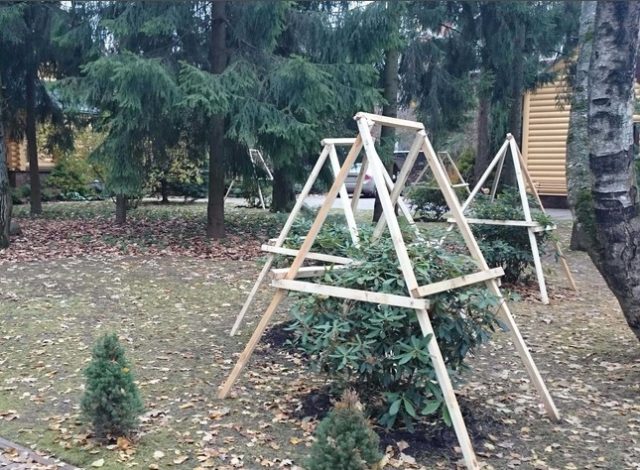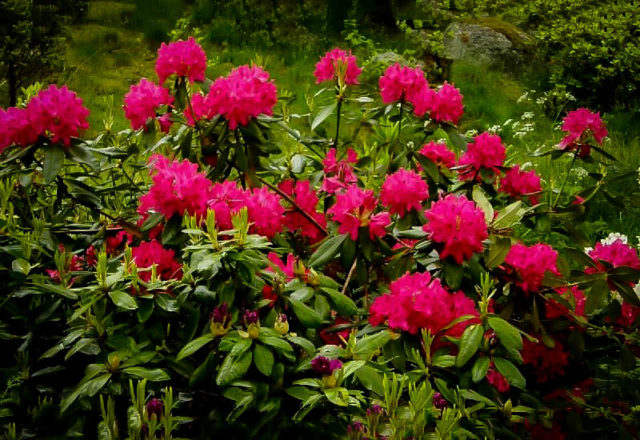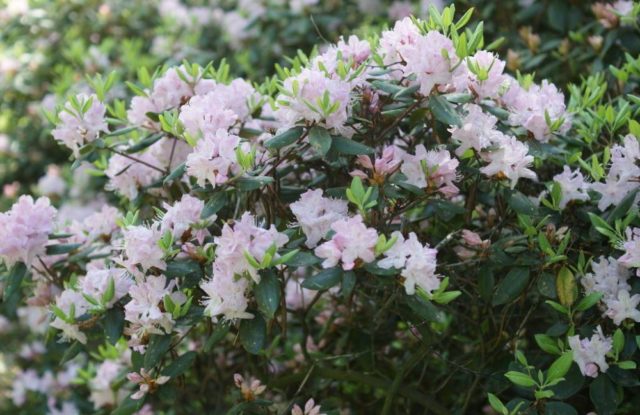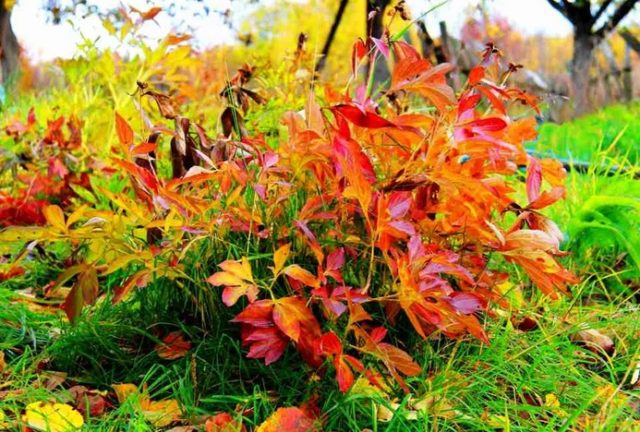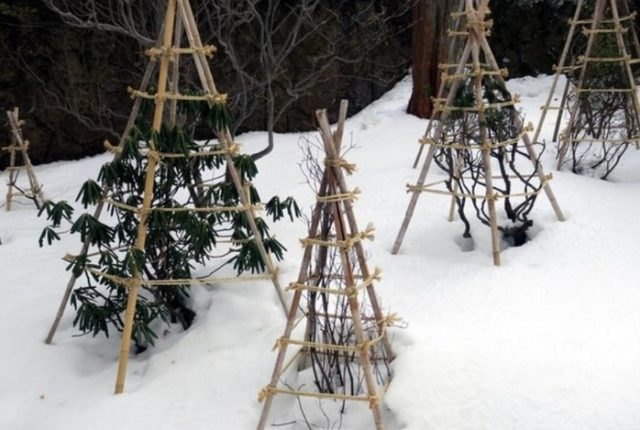Content
Caring for rhododendrons in the fall and preparing for winter will help preserve heat-loving varieties and young seedlings for spring flowering. Adult, hardy shrubs do not require the same careful shelter in winter as roses, but they bloom just as beautifully. It is useful for every gardener to know what autumn activities will help rhododendrons to survive the harsh cold weather painlessly.
Features of care for rhododendrons in the fall
These small shrubs and trees with evergreen or falling foliage for the winter belong to the Heather family. They bloom in late spring or early summer. Deciduous rhododendrons have soft light green leaves that sometimes change to beautiful reddish-orange tones in autumn. Evergreen varieties do not change color; they are green all year round. They look exotic in winter.
Like all other garden plants, rhododendrons require careful attention in autumn. Caring for evergreen and deciduous specimens does not have significant differences, but the latter are less capricious. Preparatory work for the fall includes the construction of a shelter for rhododendrons for the winter.
Autumn care tips:
- Shrubs are fed with preparations with phosphorus and potassium, without nitrogen, in order to stop the growth of new shoots.
- It is recommended to add magnesium and sulfur from trace elements.
- For the prevention of diseases, it is necessary to treat shrubs with fungicides and insecticides.
- Abundant autumn watering and mulching will protect the rhododendrons from winter frosts.
- Autumn pruning is possible when it gets colder to 0 ° C. When the temperature is above zero, it is impossible to cut off the plants; intensive growth of shoots will begin.
Many growers consider rhododendrons to be pampered plants, but this is not the case. Now there are many varieties that tolerate frost perfectly, flower buds laid in autumn do not freeze even at -30 ° C.
How to plant rhododendron in the fall
When buying a seedling in a garden center, among the zoned varieties, preference is given to the most frost-resistant. Their successful wintering and the success of further cultivation depend on the correct planting and care of rhododendrons in the fall. You cannot buy seedlings with unripe, green shoots. A strong bush that winters well has lignified shoots, growth buds are laid at the top.
Frost-resistant evergreen varieties.
Helsinki University - a compact bush, abundantly strewn with large pink flowers at the end of May.
Nova Zembla - a variety with bright red simple flowers.
Keninghams White - a shrub with delicate white inflorescences.
Green leaves can burn from bright sunlight in winter, so shelters are needed from the end of January. Deciduous rhododendrons, such as Japanese and Daurian, hibernate without shelter.
Landing dates
It is advisable to plant rhododendrons in open ground in the fall and provide care for a month before the start of frost, so that they have time to adapt, take root in warm ground. The final planting date depends on the region: in the south it is October, in the Urals and Siberia it is September. It is better not to plant crops of heat-loving varieties in the fall, they may not overwinter.
Landing site preparation
For the successful cultivation of rhododendrons, it is important to choose the right place for planting and prepare it. These plants do not have the suction roots that most ornamental shrubs do. The thin roots contain mycorrhiza, which helps the shrubs to feed and grow. Therefore, a special soil is needed - loose and sour.
Evergreen varieties are planted in light partial shade or so that tall buildings, fences, ornamental conifers cover them on the south side. Deciduous varieties can be planted in more open, sun-lit areas that are sheltered from the wind.
A planting pit with acidic soil is prepared for rhododendrons. For the soil mixture, take the following components:
- peat - 2 hours;
- vermicompost or leaf humus - 1 hour;
- pine litter - 1 tsp
For planting rhododendrons, only horse, sour peat can be used. It should be coarse with little degradation. The pit is made at least 40 cm deep and 50-60 cm in diameter. Then it is filled with the prepared soil mixture.
Rules for planting rhododendron in open ground in the fall
Before planting, the seedling is removed from the container and immersed together with an earthen clod in a bucket of water. Leave in this state for 20-30 minutes, until the roots of the plant are saturated with moisture.
Tips for planting rhododendron in the fall:
- You can not plant a shrub near plants that have a superficial root system - birch, willow. They will pick up moisture and nutrients.
- Rhododendron grows well in rows with apple, pear, pine, larch, spruce.
- If the site is close to the surface of groundwater, it is advisable to put a drainage from granite gravel, which does not give a lime reaction, to the bottom of the pit. It will keep the roots from moisture stagnation.
- To quickly create a beautiful bush, you can plant 2-3 seedlings in one large hole, placing them at a distance of about 50 cm from each other.
A soaked seedling is placed in the prepared hole. Check the position of the root collar at soil level. With a deep planting, the plant will rot, and in an elevated state, it will lack moisture. All this will affect future wintering.
To prevent a large rhododendron from being blown up by the wind, a support is installed next to it. The trunk is tied to the support peg with synthetic twine. After planting, the seedling is well watered. Mulching the trunk circle will help prepare the rhododendron for winter. Heather compost or sour high-moor peat is used as mulch, which will serve as an additional source of nutrients for the shrub when the ground thaws in spring.
Transplanting a rhododendron in the fall to another place
If the plant does not bloom, grows poorly or begins to wither, you can transplant it in the fall by renewing the soil in the old pit or choosing a new place. A transplant may be necessary due to a poorly chosen place where cold winds blow or the water comes close to the surface. Sometimes the variety is so beautiful that you want to plant a plant closer to the front door of the house.
The plant has a shallow, fibrous root system, making it easy to dig up. Work is best done in September so that the rhododendron has time to take root. Transplant procedure:
- In a new pit, an acidic soil is prepared from high-moor peat and coniferous litter.
- Dig in the bush around the perimeter of the crown with a sharp shovel.
- Raise by supporting the trunk.
- Slightly clean the soil from the roots.
- Transplant the bush to a new place so that the root collar remains at the soil level.
- Watering and mulching the trunk circle.
After transplanting rhododendron in the fall, prophylactic spraying with copper-containing preparations is done. In green shrubs, leaves are treated not only superficially, but also from the inside. For the winter, the trunk circle is mulched with pine litter or sour high-moor peat.
How to care for rhododendron in autumn
The autumn set of measures for the cultivation of various types of rhododendrons is similar. While it is warm, you can carry out the last dressing, plant young seedlings or transplant adult bushes to a new place where they will look more advantageous. Closer to the middle of autumn, when deciduous varieties begin to fly around, and the approach of cold weather will become more noticeable, they carry out pruning and water-charging watering, mulch the trunk circle. In November, ripe seeds are harvested for growing seedlings. For thermophilic varieties, frames are prepared from flexible pipes or wooden beams. Cover the bushes selectively, only with the onset of persistent cold weather.
In autumn, the leaves of deciduous rhododendrons turn yellow. Under the bright autumn sun, they acquire a golden yellow, orange or red color, which looks no less beautiful than the spring bloom. Evergreen rhododendrons slightly lose leaf turgor, preparing for a cold snap, but they do not change their green color. Fallen leaves are not removed in autumn from under healthy bushes. It will serve as additional food for plants. Mulch is poured over the litter along the entire trunk circle.
Watering rhododendrons in autumn
Rhododendrons are very demanding for watering. They must not be poured or dried. During the growing season, they monitor the moisture in the trunk circle, make diverting grooves for excess moisture, mulch the soil so that it does not dry out.
Water-charging irrigation of evergreen and deciduous rhododendrons is a mandatory autumn event. Each plant cell must be saturated with moisture, this will protect it from freezing in winter. At least 30-40 liters of water are poured under each bush up to 1 m high.
Water-charging watering of rhododendrons begins, when the air temperature drops to +2 ° C, leaves begin to fall off.
Top dressing
In late summer and early autumn, rhododendrons are fed with potassium monophosphate in order for them to lay flower buds for the next year. Fertilizer will help the shoots that have grown after flowering to ripen to frost. Top dressing is applied when the soil temperature is above +10 ° C.
Potassium monophosphate (1 tablespoon without top per 10 liters of water) is best applied under the plants in the evening, watering along the edge of the bush. For 1 sq. m of area consume a bucket of solution. On the leaves, you can treat rhododendrons with fertilizer with microelements - "Uniflor", which will additionally protect plants from fungal infections.
Pruning
In order for rhododendrons to bloom profusely, you need to rejuvenate adult bushes with pruning. This is done about 10 days after fertilizing the soil, before the onset of frost. Depending on the region, the time for the autumn event falls in late September or mid-October. In the fall, sanitary pruning is also carried out, removing diseased and broken branches that can become a source of disease. Places of cuts are covered with Ranet paste.
How to preserve rhododendrons in winter
The gardener's task is to help rhododendrons survive the winter in the open field with minimal losses. These plants are very hardy and can freeze out young, freshly planted specimens or thermophilic varieties.
To make it easier for rhododendrons to endure the winter, it is advisable to plant the plants in groups. Nearby can grow heather, hydrangea, conifers, which love acidic soil. When the air temperature drops to -4 ° C, the leaves of the evergreen rhododendrons will curl into tubes. So, they prepare for winter by closing the stomata on the underside of the leaf plates, through which moisture evaporates.
More than frost, rhododendrons are afraid only of cold winds and the bright February sun. At the end of winter, when the sun begins to shine more intensely, the twisted leaves begin to evaporate moisture, and the roots from the frozen ground cannot make up for its lack. At this time, it is advisable to shade the plants.
Whether to shelter the rhododendron for the winter
To decide whether a rhododendron needs shelter in winter, you need to know in which frost resistance zone it can be grown. Deciduous shrubs tolerate temperate winters more easily. In nature, some species of rhododendrons grow in Kamchatka and Siberia, where it is cold in winter. Hybrid evergreen varieties are less frost-resistant, therefore, seedlings are covered in the first 3 years after transplanting into open ground.
When to cover rhododendrons for the winter
The shelter is fixed on a support around the bush when the air temperature is -10 ° C, otherwise the shoots will mate. Prior to this, training is carried out:
- top dressing;
- watering;
- fungicide treatment;
- mulching of near-trunk circles;
- installation of frameworks over groups of rhododendrons or separately growing bushes.
When frosts begin, cover the bushes on top of the frame with spunbond or lutrasil. On warm days, the edges of the covering material are raised to a small height from the ground on both sides of the shelter to ventilate the plants.
How to shelter rhododendrons for the winter
Even adult rhododendrons need shelter from the wind. Do not make it too dense, as for roses, shrubs are prone to rotting. The choice of shelter depends on the size of the plant. A small rhododendron can be covered with pine litter for the winter, fixing it on top with spruce branches. And when the snow falls, throw a snowdrift on top - the plant is not afraid of frosts under the snow cover.
The root system of rhododendrons is located close to the surface; in the fall, it is necessary to spud the trunk circle to protect the plants from frost. The mulch layer depends on the height of the shrub. For a rhododendron up to 1 m in height, a layer of mulch of 4-5 cm is sufficient. In large specimens, the soil is mulched to a height of 15-20 cm. For this, dry pine needles mixed with peat are used.
To cover the trunk and shoots from the winter sun, burlap is suitable, but the film cannot be used, air must freely pass through the surface of the covering material. Burlap will protect plants from drying sun rays, wind and birds that love to feast on flower buds. Small deciduous rhododendrons can be covered with oak leaves before severe frosts.
Spruce branches are suitable as insulation. It is better not to use hay and straw, mice like to settle in them. Another way to protect against frost is to create a frame for sheltering rhododendrons for the winter.
Shelter frames for rhododendrons
Rhododendron bushes are spreading, when a lot of snow falls on top of the shelter, it will break the branches, so it is advisable to build a rigid frame. The shape of the frame base should be pyramidal so that the snow rolls down to the ground. The frame is installed in early autumn, when the ground is not yet frozen. With the onset of cold weather, a protective material is pulled from above in 1-2 layers.
The size of the frame base depends on the diameter of the crown and the height of the shrub. The gap between the covering material and the shoots should be about 15 cm, since in places of close contact, the plant tissues freeze.
Arcs are usually installed at a distance of 35 cm from each other. To strengthen the covering material on the frame, it is tied at the bottom with a rope or pressed to the ground with bricks. Near the bush, you can simply drive in a high support and throw a covering material on top to protect the shoots from snow and the scorching sun.You can make a simple and reliable shelter for a rhododendron with your own hands from three poles, burying them around a bush, and tying them at the top in the form of a wigwam. And put covering material on top.
How rhododendron tolerates winter
Rhododendrons hibernate well under cover. Even young seedlings planted in open ground on the eve of autumn are not damaged by frost. This is provided that the planting material is of high quality and the planting is correct.
The bushes, carefully sheltered before the onset of severe frosts, which have laid flower buds, will certainly bloom. In the spring, do not rush to open rhododendrons when the bright sun is shining and the earth has not yet warmed up. In March, you can water the tree circle with warm water to help the plants absorb moisture after a long winter. Rhododendrons are discovered, which hibernate under cover when daffodils and tulips bloom. It is advisable to do this in cloudy weather. Dried, diseased shoots are cut out to healthy tissue, and all bushes are treated with fungicides.
If, after removing the shelter, the leaves of the evergreen rhododendron did not straighten, but remained in a folded position, then it has lost a lot of moisture in winter. The plant is sprayed and watered daily until the leaves are spread. So that the ground under the bush warms up faster, they rake off the mulch and watered with water with the addition of growth stimulants (dilute one ampoule of "Zircon" or two ampoules of "Epin" into 10 liters of water). Mulch the bush when the soil warms up well.
Conclusion
Caring for rhododendrons in the fall and preparing for winter will require a little time from the gardener. The bloom does not last long, but it is so beautiful that it is worth all the work invested during the year. When growing these plants, everyone is afraid of winter. In fact, frosts are not so bad. The death of rhododendrons can only be caused by inattention, mistakes made when choosing a variety, incorrect autumn planting or preparation for winter.
